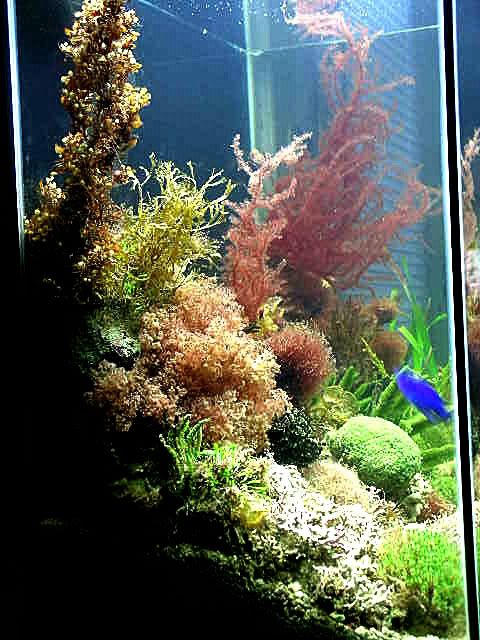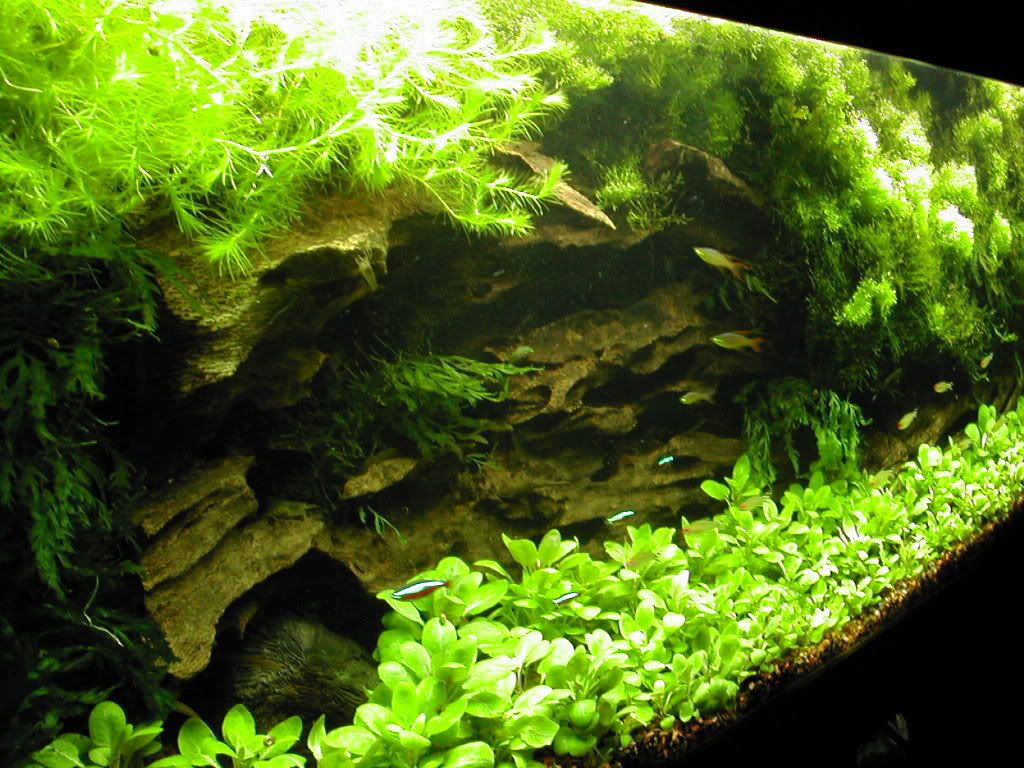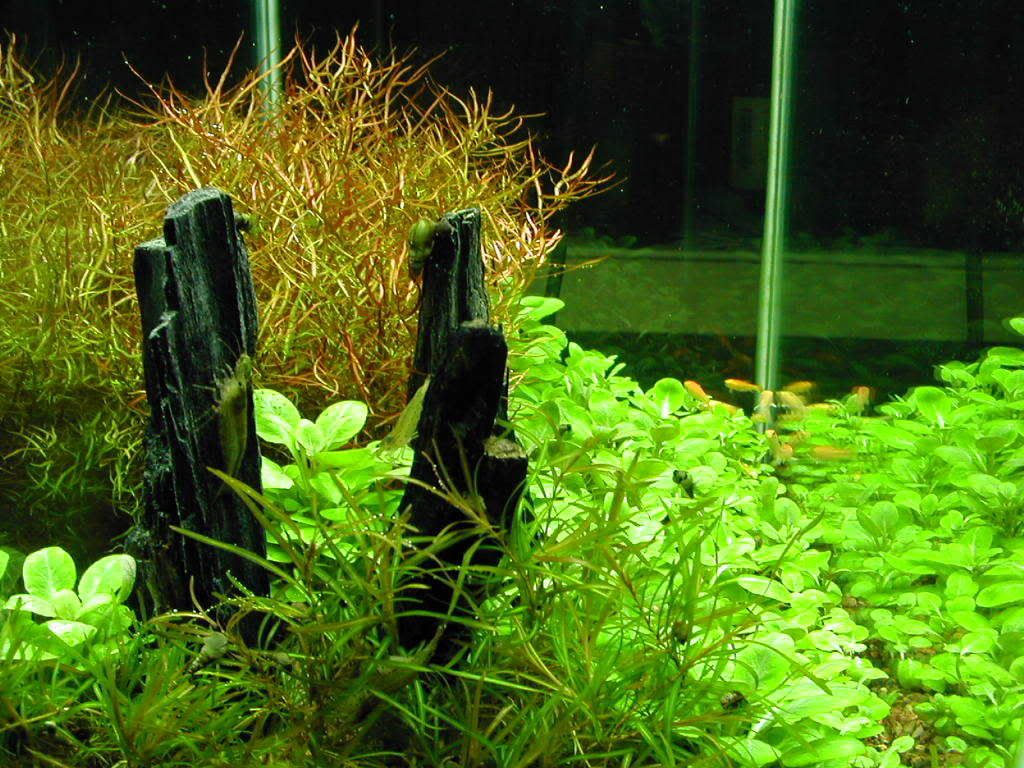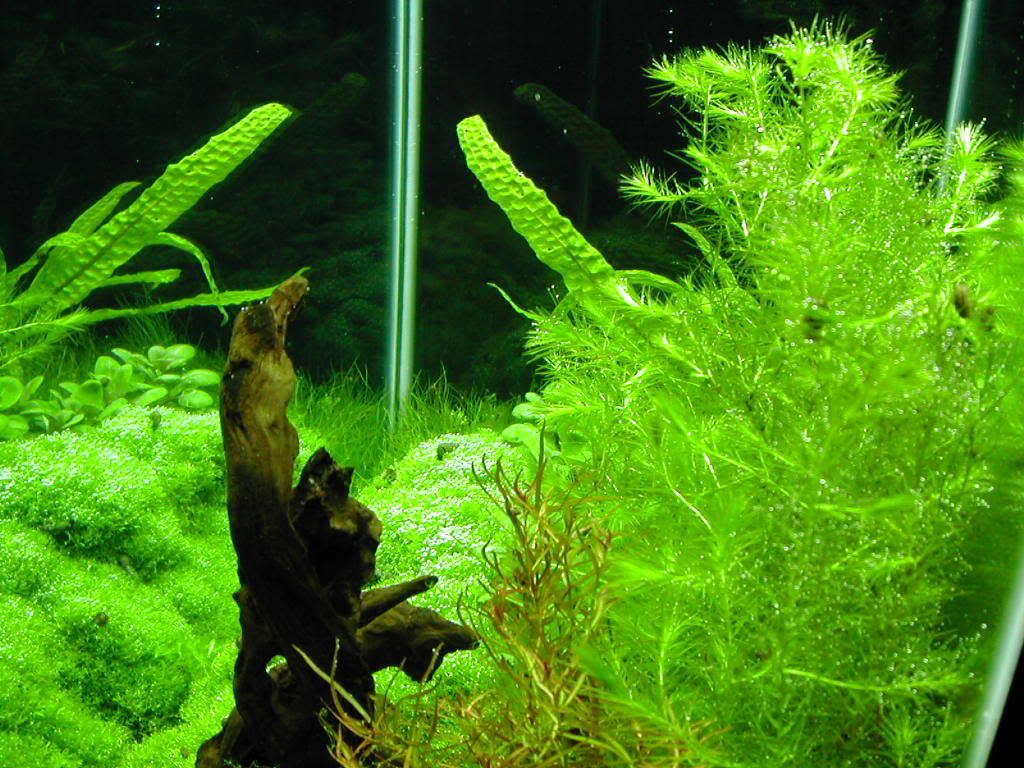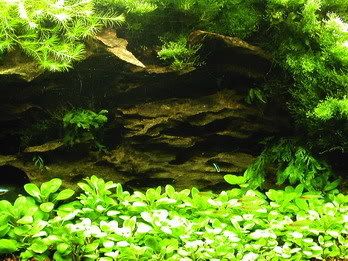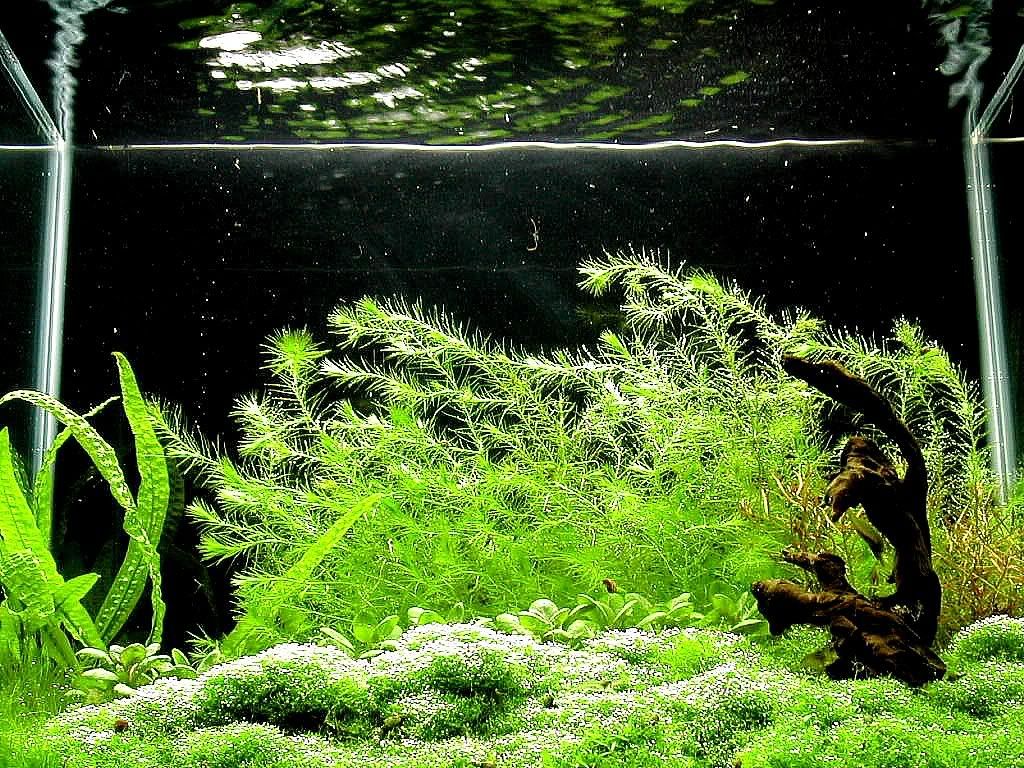I can recognize in the picture (see indicated places) that the Cuba branch out there
* krueppelt * come further in front through net optimal fertilization, but ueberduengung!
I have a nice example from our laboratory where the same plant and genetic stock is very similar without
any water column fertilization.
the system has a flow through DI water system so that all the nutrients must come from the sediment exclusively.
This allows me to compare nutrient sources for plants.
an excellent paper, that's likely in german or Dutch, is Madsem and Cedergreen, 2002 from Freshwater Biology. It details out several plants using both sources of nutrients.
A good interesting paper that supports our observations in the Aquariums.
I remove approx.. 50-80% biomass every two weeks in basins with much light and many stack plants. I also, but only the weight of the plants (dripping wet) with withdrawal is nevertheless interesting sign
Yes, you can measure the rate of uptake of PO4 by the plants.
Most plants are fairly tolerant of PO4 limitation however.
So what are the real issues with low PO4?
Well less growth, less NH4 uptake, less NO3 uptake.
If those are limiting or unknown or poorly measured, this can lead people to assume many other potential causes based on correlation, not real causation.
Here's an example: If you limit the PO4 severely, this will reduce the CO2 demand. If you add say 15 ppm CO2, that might be okay to meet the plant's demand with limiting PO4, if you provide non limiting PO4, then the CO2 demand might be 30ppm now.
So the CO2 is now limiting, but adding PO4 caused it, still, the CO2, not the PO4 caused the stunting or algae or poor plant growth, not the PO4 directly.
When we test things, we need to be certain that the other parameters are non limiting!!
This was not done(by many reputable people) and is still rarely done by aquarists, so they often believe in many myths caused by this and get frustrated.
Confounding factors such as other parameters causing interference (becoming limiting) can mislead us and fool us.
We need to confirm and make sure things are good before making such conclusions.
This was not done in the past, many never bothered to set up a proper test.
That was a bit disturbing to me initially.
But folks still do it today and make the assumptions even though the evidence, the methods on how to test for it and what not are very available ands there's strong evidence for it in research.
Now add some at NH4, into an otherwise sturdy strong light basin with CO2 supply, in addition = algae. No! ... so long the basin water NO3 worth of 5-2 mg/l exhibits. That worth increased over 10 mg/l. I fertilize my basins also with ammonium. Algae, no I do not have no also my aquarium friends also in such a way fertilizing to have algae. PO4 = 0.1-0.08 mg/l N03 = 2-5 mg potassium = 5-10 mg/l C02 = 20 - 40 mg/l KH = 2-5 GH = 4-10 Water change of these basins 50-90% of every 3 - 7 days.
Not quite sure, the translation engine chowed this one up bad in English

But the above parameters will and should work okay as long as the supply is maintained and added. Light intensity is also generally lower in Europe than the USA, and less light = less nutrient demand, something I've strongly advocated for many years.
But that does not imply higher nutrient slevels, say 50ppm K+, 20ppm NO3, 2-3ppm of PO4, GH of 4-10, weekly water changes every 3-7 days does not work well.
As far as NH4, I think you mean that you add it and get no NH4, this is a two edge sword though. If you do large massive daily or 2-3 day water changes, this can and does work, and if you have less lighting as well.
The CO2 at 20-40ppm is a wide range but should be non limiting if the lighting is moderate.
I am very critical of CO2 measurements due to many factors in the measurements(KH and interferences)
Still, few aquarist bother to measure or test light using a PAR meter and see actually how much light an individual plant might get to see.
Here to the opinion also a few pictures of plant lovers - who are announced in the forum here. By basins where the fertilization with extraordinarily limited values to be led! (thanks at plant friend, Werner for the pictures) Werner its basin in full splendour... Plant friend its basin... Few of me... Result: But altogether one must regard evenly much from two sides... Sign A simple question in the end: Tom, why thus one is to drive so high values, if it goes with low values still better?
I think the reason is to show that are not bad as many have claimed.
I obviously have awesome plant growth, as well.
Both lean and rich nutrients provide dramatic colorful plant growth.
Is this suprising?
No, not really, plants have a wide range of parameters.
If we use these wide ranges, we can make our lives much simpler and easier and avoid testing altogether.
Which I have never met anyone, no hobbyists that got into this hobby to learn how to test aquarium water!
Have you?
If we go a little over, it's no big deal if the other parameters are in good shape.
Many have claimed that high PO4, NO3, FE, etc cause algae, yet I've easily proven otherwise for decades now.
As far as plant health, plants grow faster with more, not less nutrients if the CO2 and light are balanced.
If the balance is messed up, or the other factors, especially good CO2 are not accounted for, then problems can occur, then they blame the PO4, not the CO2 or high light etc.
Lower light is better and more stable if you seek a less demanding tank.
We all have very different goals, no one method will meet all of those for all aquarists.
My goals are to show what has been said is dead wrong.
I've proven it quite well and shown that what's long be said is wrong through falsification of their hypothesis.
Several folks here have won the aquascaping contest using the richer methods.
I've found causation for a dozen species of algae.
If "less is better" is your goal, then we should use a non CO2 plant method?
Less CO2 will slow growth. That will reduce the demand for nutrients so we can have less.
Light drives growth which drives CO2 demand and uptake which drives N uptake and P uptake and so on down the line.
Light => CO2 demand=> N uptake(NH4/NO3)=> K+ uptake=> PO4 etc.........
You need to have a clear picture of all of these to really say much about the system.
I've yet to meet any aquarist that measures all of these in the correct botantical units(PAR for light, gooid highly accurate CO2 measure, eg a pH reference probe with a KH reference solution and CO2 standard for calibration, good calibrated nutrient measurements) that we can compare things fairly with to date with the exception of Ole or Claus but they are professionals that are active growers or professors etc. The same is true with the researchers here in the USA.
It's the hobbyists that get confused and make the assumptions :idea:
Plants grow quite well in both situations, the fewer limitations, the faster they will grow.
If you seek to control growth for scaping etc, then reduce the light intensity.
that will make all the other demands far far less.
If you limit anything, it should be light, not nutrients.
You still get nice foregrounds, nice plants etc.
Here's a link to the lower light ADA tank that's been up for 1 year, with 1.5 w/gal on light:
You can run tanks with no nutrient dosing at lower light and a rich sediment.
I've been doing that as well.
Or no CO2, or marine macro algae etc.
All sorts of various methods are out there!
Most people only know one method well.
I suggest that to expand one's knowledge and reduce their assumptions, test and try these out for yourself and dose KH2PO4 and see for yourself.
Be careful to watch the other nutrients, CO2 and NO3 in particular.
Regards,
tom Barr
Ãœbersetzung:
Ich kann auf dem Bild erkennen (siehe angezeigte Stellen) das die Cuba sich dort verzweigt weiter vorne *krüppelt* das kommt durch net Optimale Düngung, sondern Überdüngung! Das tut sie nicht, bei *mageren* Werten.
Zur Ansicht was ich meine das Bild nochmal....
Ich habe hier als Vergleich eine Pflanze, mit gleichem genetischen Material, aus unserem Labor, die genau den gleichen Wuchs zeigt, jedoch ohne irgendeine Düngung über die Wassersäule.
Dieses System hat einen Durchlauf mit destilliertem Wasser, so dass alle Nährstoffe aus exklusiv aus dem Sediment kommen.
Dies erlaubt mir genaue Rückschlüsse auf Nährstoffvorlieben von Pflanzen zu ziehen.
Eine tolle Arbeit hierzu, die wahrscheinlich in deutsch oder holländisch geschrieben wurde, kommt von Madsem und Cedergreen 2002 aus dem Bereich Frischwasserbiologie.
In der Arbeit wird herausgearbeitet, dass viele Pflanzen beide Bereiche (Sediment und Wassersäule) als Nährstoffquelle nutzen.
Es ist eine interessante Arbeit, die unsere Beobachtungen im Aquarium untermauert.
Ich entferne ca. 50-80% Biomasse alle zwei Wochen in Becken mit viel Licht und vielen Stengelpflanzen.
Ich auch, aber nur das Gewicht der Pflanzen (Tropfnass) bei Entnahme ist doch interessant Wink
Ja natürlich kannst du die Aufnahmerate von PO4 bei den Pflanzen messen.
Wobei die meisten Pflanzen sehr tolerant gegenüber einer PO4 Limitierung sind.
Was ist also das wirkliche Problem eines geringen PO4 Wertes?
Ich würde sagen weniger Wuchs, weniger NH4 Aufnahme und weniger NO3 Aufnahme.
Wenn diese Faktoren limitiert, unbekannt oder schlecht gemessen werden kann dies dazu führen, dass Leute irgendetwas annehmen, was lediglich auf Korrelation basiert und keine wirkliche Kausalität aufweist.
Hier ein Beispiel: Wenn du PO4 stark limitierst wird der CO2 Bedarf stark absinken. 15 mg/l CO2 sollten diesen Umständen einer PO4 Limitierung gerecht werden und decken den Bedarf der Pflanzen. Bei unlimitierten PO4 Verhältnissen reichen diese 15 mg/l bei weitem nicht und du musst viel eher einen Wert von 30+ mg/l CO2 anstreben.
Aus diesen Grund ist CO2 hier der limitierende Faktor, der durch das Hinzufügen von PO4 entstanden ist. CO2 ist somit auch für die Verkrüppelungen verantwortlich oder auch Algen und schlechten Wuchs der Pflanzen. Wir können es aber nicht direkt auf das PO4 beziehen, auch wenn wir hierdurch die Kette in Bewegung gesetzt haben.
Wenn wir Dinge testen, müssen wir sicher sein, dass die anderen Parameter nicht limitiert sind! Dies wurde eben nicht gemacht (von vielen bekannten Personen) und wird von Aquarianern noch immer sehr selten durchgeführt. Aus diesem Grund glauben sie oft an solche falschen Zusammenhänge und Mythen die daraus entstehen und sind frustriert.
Sich beeinflussende Faktoren, wie solche die dafür sorgen, dass andere Parameter limitierend werden, können uns hier zu falschen Schlüssen führen und somit an der Nase herumführen.
Wir müssen uns absolut sicher sein und dies auch belegen können, damit wir solche Aussagen treffen können. Dies wurde in der Vergangenheit oft nicht gemacht, da viele keine richtigen Tests durchgeführt haben.
Dies hat mich am Anfang etwas irritiert. Aber noch immer machen es die Leute so und ziehen Rückschlüsse aus solchen Versuchen, obwohl es mittlerweile genug Anleitungen gibt wie man richtig testet und man findet bezüglich dieser Punkte immer wieder starke Beweise in der Forschung.
Nein! ...solange das Beckenwasser NO3 werte von 5-2 mg/l aufweist. Wird der wert erhöht über > 10 mg/l JA.
Ich dünge meine Becken auch mit Ammonium.
Algen, nein habe ich keine auch meine Aquarienfreunde die auch so Düngen haben keine Algen.
PO4 = 0,1-0,08 mg/l
N03 = 2-5 mg
Kalium = 5-10 mg/l
C02 = 20 - 40 mg/l
KH = 2-5
GH = 4-10
Wasserwechsel dieser Becken 50-90% aller 3 - 7 Tage.
Hier bin ich mir nicht ganz sicher was gemeint war, da die Ãœbersetzungsmaschiene nicht gerade gutes Englisch hervorgezaubert hat.
Aber die oben genannten Werte funktionieren ohne Zweifel, so lange sie konstant gehalten werden und regelmäßig hinzugefügt werden. Das Licht über dem Aquarium ist in Europa oft viel geringer als hier in den USA. Weniger Licht = weniger Nährstoffbedarf, etwas was ich seit Jahren unterstütze.
Aber es sagt noch lange nicht aus, dass höhere Nährstoffwerte wie 50 mg/l K+, 20 mg/l NO3, 2-3 mg/l PO4, GH 4-10 mit wöchentlichen Wasserwechsel nicht gut funktionieren.
Ich denke bezüglich NH4 meintest du, dass du es in deine Becken düngst. Dies ist ein zweiseitiges Schwert. Wenn du große Wasserwechsel alle 2-3 Tage machst kann es gut funktionieren, bei weniger Licht ebenfalls.
Der CO2 Wert sollte bei 20-40 mg/l liegen, was eine breite Spannweite ist, jedoch sollte er selbst unter moderatem Licht unlimitiert zur Verfügung stehen. Ich bin bei der CO2 Messung sehr genau, da viele Faktoren die genaue Bestimmung beeinträchtigen (KH und andere beeinflussende Stoffe).
Noch immer kümmert es aber wenig Aquarianer wieviel Licht sie über ihren Becken haben. Die wenigsten nutzen ein PAR Meter, um die Lichtintensität genau zu bestimmen und um wirklich zu sehen, wieviel bei den Pflanzen noch ankommt.
Hier zur Ansicht auch ein paar Bilder von Pflanzenliebhabern - die hier im Forum gemeldet sind. Von Becken wo die Düngung mit außerordentlich limitierten Werten geführt werden! ( Danke an Pflanzenfreund, Werner für die Bilder)
Werner sein Becken in voller Pracht...
Ich glaube der Grund liegt daran den Leuten zu zeigen, dass höhere Nährstoffkonzentrationen nichts schlechtes sind, so wie es viele Behauptet haben.
Ich habe mit diesen Werten trotzdem sehr guten Pflanzenwuchs.
Sowohl niedrige Nährstoffwerte wie auch hohe produzieren atemberaubend farbenfrohe Pflanzen.
Ist dies überraschend?
Nein, nicht wirklich. Pflanzen haben eine große Spannweite bei den Nährstoffwerten. Wenn wir diese Spannweite nutzen, können wir unser Leben sehr viel einfacher halten und müssen ebenfalls nicht mehr Testen.
Ich habe bis jetzt noch keinen Aquarianer kennengelernt, der dieses Hobby begonnen hat, um Aquarienwasser zu testen!
Hast du es deswegen begonnen?
Wenn wir ein bischen über diesen Werten liegen macht dies noch nichts, so lange die anderen Werte stimmen. Viele haben in der Vergangenheit behauptet, dass hohe PO4, NO3 und FE, etc. Werte zu Algen führen. Ich konnte dies alles leicht Widerlegen und das bereits seit Jahrzehnten.
Bezüglich der Pflanzengesundheit kann ich nur sagen, dass Pflanzen mit mehr Nährstoffen auch besser wachsen, nicht mit weniger. Hierfür muss aber das CO2 und Licht darauf ausgerichtet sein.
Wenn diese Balance nicht stimmt, oder andere Faktoren, im Besonderen man CO2 nicht die richtige Beachtung schenkt, kann dies zu Problemen führen. Viele bezichtigen dann das PO4, anstatt das CO2 oder viele Licht als Übeltäter etc.
Weniger Licht ist immer besser, wenn man sich ein stabileres, weniger Arbeit erforderndes Becken wünscht.
Wir alle haben sehr unterschiedliche Ziele, keine Methode wird allen Aquarianern gerecht werden können. Mein Ziel ist es zu zeigen, dass vieles was Behauptet wurde falsch ist.
Ich habe dies gut belegen können und auch durch Falsifikation ihrer Hypothesen zeigen
können.
Einige Leute haben bereits Aquascaping Contests mit diesem unlimitierten Nährstoffangebot gewonnen.
Ich konnte zudem einen Kausalzusammenhang für dutzende Algenarten feststellen.
Wenn „weniger ist besser“ dein Ziel ist, solltest du dann nicht ein Becken ohne CO2 anstreben? Weniger CO2 wird den Wuchs eindämmen. Aus diesem Grund können wir noch weniger Nährstoffe hinzufügen, da der Bedarf dieser weiter abgesunken ist.
Light beeinflusst primär den Wuchs, welches den CO2 Bedarf ankurbelt und dieses wiederum den Nitratbedarf und den Phosphatbedarf und so weiter…
Licht => CO2 Bedarf => N Bedarf (NH4/NO3) => K+ => PO4 usw.
Man braucht schon einen genauen Überblick hinsichtlich dieser Stoffe, um wirklich etwas über ein System auszusagen.
Ich habe bis jetzt noch keinen Aquarianer getroffen bzw. gesehen, der all diese Variablen in korrekten Einheiten misst, die in der Botanik genutzt werden (PAR für Licht, Gute verlässliche CO2 Bestimmung wie z.B. einer Referenzelektrode, mit einer Referenz KH Lösung und einem CO2 Standardwert nachdem kalibriert wird, gute kalibrierte Nährstoffbestimmung), damit wir unsere Werte gut vergleichen können. Bis jetzt fallen mir lediglich Ole und Claus ein, welche jedoch professionell auf dem Gebiet arbeiten, als Wasserpflanzengärtner oder als Professor. Das gleiche gilt auch für die Forscher hier in den USA.
Es ist und bleibt der Aquarianer der seinem Hobby nachgeht, der durch diese Umstände verwirrt wird und falsche Annahmen macht.
Pflanzen wachsen in beiden Situationen sehr gut, je weniger Limitationen man hat, desto schneller wachsen auch die Pflanzen. Wenn man den Wuchs eindämmen möchte, z.B. für die Aquariengestaltung, dann sollte man primär das Licht reduzieren. Durch diesen Eingriff senkt man den Bedarf der anderen Faktoren erheblich.
Wenn man etwas limitiert sollte dies Licht sein und nicht die Nährstoffe. Auch mit weniger Licht bekommt man einen schönen Vordergrund und hübsche Pflanzen zustande.
Hier ist ein link zu einem ADA Becken mit weniger Licht, welches seit über einem Jahr steht und lediglich 0,4 W pro Liter hat.
Man kann Becken mit weniger Licht ohne Nährstoffzugabe über die Wassersäule halten, so lange man einen nährstoffreichen Bodengrund hat.
Ich betreibe dies ebenfalls so.
Oder kein CO2, oder Marine Makroalgen etc.
Alle möglichen Methoden gibt es.
Viele Personen kennen nur eine sehr genau…
Ich schlage vor, dass man sein Wissen erweitert und seine bloßen Annahmen außen vorlässt. Testet und versucht es für euch selber und dosiert KH2PO4 und schaut was passiert.
Hierbei natürlich die anderen Nährstoffe im Auge behalten wie CO2 und NO3.
Grüße,
Tom Barr
 .
.













